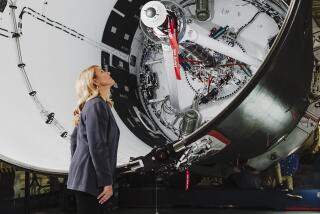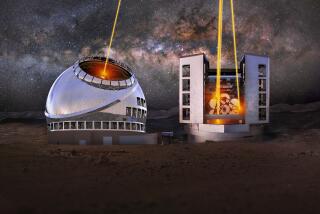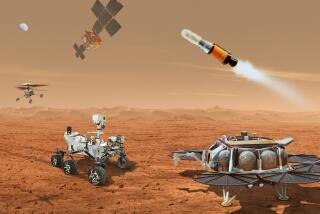NASA : Honoring a Space Agency That Works
BRUSSELS — Ten years ago this week, the spaceship Challenger exploded as it climbed away from southern Florida on a baluster of fire. Following this tragedy, things kept getting worse for NASA: launches were suspended, rockets blew up, budget increases led to nothing, officials responsible for the Challenger disaster were never punished. Five year ago, NASA, once the epitome of can-do accomplishment, had become synonymous with institutional decay.
Today, that situation is almost completely reversed. NASA space operations, though far from problem-free, are once again regular and reliable. Launches are up, even though the agency is cutting its budget in “real” dollars. The National Aeronautics and Space Administration has managed something government agencies constantly talk about, but almost never achieve--a notable reduction in staff. Entrenched, top-heavy programs are giving way to decentralized, innovative projects that deliver more return for the dollar. The head-line news for the 10th anniversary of the Challenger loss is surely this: NASA has made a dramatic institutional recovery, one of the greatest in the annals of U.S. government.
Credit for this should go, first, to a place credit almost never goes: the vice president’s office. During the Bush Administration, Vice President Dan Quayle instigated serious reform at NASA, over the howls of aerospace contractors--normally untouchables in GOP administrations. In retrospect, instigating NASA reform appears the substantive accomplishment of Quayle’s term.
In turn, Vice President Al Gore deserves commendation for pressing ahead with reform. In some quarters, space is seen as the final frontier of Democratic politics--President Richard M. Nixon often complained that all the acclaim for the moon race went to President John F. Kennedy, while most of NASA’s operational centers went, under Lyndon B. Johnson, to the mainly Democratic states of Alabama, Florida, Maryland, Ohio and Texas. The NASA old-boy faction assumed when Democrats returned to the White House, uncomfortable questions would stop being asked. Instead, Gore turned up the heat, and has now achieved something everyone else in Washington only talks about: the successful “reinvention” of a government agency.
The instrument of that reinvention has been NASA Administrator Daniel Goldin. a Southern Californian. Goldin came to NASA in early 1992--the closest thing to an outsider ever to head the agency. Goldin’s background was making satellites, not the manned-space hierarchy that had supplied all previous NASA chieftains. Satellite manufacturers like cheap, simple, automated solutions to space problems. This made Goldin anathema to the NASA old-guard--which had come to believe even turning on a light bulb in space required a half-dozen astronauts in a billion-dollar sky chariot. But Goldin possessed the rare trump card of two-party White House backing. He was selected for office by the Bush Administration, then kept on by Bill Clinton--both presidents being impressed with his determination to return the United States to space success.
Usually, federal officials who challenge their own bureaucracies are either swallowed up in red tape or slowly pecked to death. Goldin, however, forced NASA to confront its inertia. Whole offices were abolished. Layers of management were peeled off. Goldin managed to shut down an entire layer of space-station redundancy--one with the Monty Pythonesque name of “Level Two”--and soon found that the space station effort functioned better with fewer executives.
Goldin took on NASA’s rampant featherbedding. During the mid-1960s, the space agency had about 1,200 civil servant employees per space launch. By 1991, the figure was around 2,500 per launch--even as computer technology allowed most high-technology private firms to do more with less workers. The space agency had contracted British Admiralty Disease--the number of senior officers was rising even as the number of ships to command declined. By fiscal 1994, Goldin had the NASA employee total down to less than 2,000 per launch, and still falling. The work force assigned to the shuttle dropped from 34,000 to 28,000, and a NASA reduction of about 5,000 more civil servants is planned for the next five years.
NASA has recorded numerous other recent accomplishments. The space shuttle has now flown 74 times--48 since the Challenger tragedy--and while the shuttle’s overall cost-effectiveness remains debatable, at least under Goldin the cost per mission has declined. Last year, NASA completed the complex effort of contracting out most shuttle launch services at the Kennedy Space Center. This should both constrain future spending and begin the process of establishing space “delivery” companies that respond to market forces, along the lines of air-cargo firms.
Meanwhile, NASA has set in motion the eventual retirement of the shuttle, by commissioning two all-new space vehicles--with the unfortunate, Buck Rogers names of X-33 and X-34. The X-34 is designed to be a relatively small, winged robot craft for launching satellites and supply payloads at a fraction of current costs. The X-33 will be a larger, “single stage to orbit” vehicle with all parts fully reusable: It may blast off, fly to space in one piece and return to its launch pad to land vertically with engines firing in reverse--just like rockets did in 1930s Saturday afternoon serials. If these projects are successful, they will be the first to address the greatest structural defect of all space programs--the high cost of putting pounds into Earth orbit.
Goldin had made the X-33 and X-34 programs unusual in other ways. First, he gave private aerospace engineers the freedom to draw up their own concepts, instead of mandating they execute a NASA committee-rendered design. This may make spacecraft manufacturing more like the airplane business. And Goldin has insisted U.S. contractors give fair consideration to the low-cost propulsion designs that came out of the Russian space program. U.S. aerospace contractors hate Russian propulsion hardware, because it lacks the glamorous max-tech appeal of, say, the 30,000-RPM turbo-pumps on the shuttle main engines. But Russian rocket engines are cheap and reliable. Goldin likes cheap; space exploration needs cheap.
In relations with the Russians, NASA has done as well as or better than any U.S. government agency. Goldin insisted, over the objections of many of his managers, that NASA make a huge concession to Moscow--the new cooperative space station will use an orbital “inclination” (position in space) that is convenient for Russian launch centers but not the Kennedy Space Center. This decision kept the entire Russian space program in business--a great gesture of friendship by Goldin, and a welcome shot of prestige for the Yeltsin government. The new space station has become a true joint U.S.-Russian endeavor.
Other good things are happening at NASA, even as the budget falls. The agency’s long-delayed environmental research satellite program is finally to begin. Repaired, the Hubble Space Telescope is now demonstrating its worth--almost every week brings word of a new Hubble finding like, say, the universe is 40 billion galaxies bigger than had been assumed the week before.
NASA’s philosophy of launching occasional huge, multibillion-dollar planetary probes, then holding its collective breath (of the last two billion-dollar mega-probes, Mars Observer failed and the current Galileo mission to Jupiter has been only a partial success), is being replaced with a new theory of lots of small, relatively inexpensive space probes that take advantage of new miniaturization technology to cut launch costs.
The next red planet mission, Mars Pathfinder, will involve a probe only about the size of a typewriter, yet able to drive on the Martian surface. Goldin wants NASA to start firing one probe at Mars every time the zodiac of planetary alignment allows it--roughly, once every two years--rather than the current Mars-mission rate of once a decade. A little probe called Pluto Express is in the works; it will be the first to fly out to the most distant planet, and yet will cost $400 million, less than a third of Galileo.
The successful rejuvenation of NASA not only shows that government agencies can be rescued from the doldrums--it holds out of the hope of a new, affordable exploration of space. Lately, Goldin has been saying the glory days of NASA are no longer in the past--rather, “the best is yet to come.” Just a few years ago, that might have seemed a gag line; today, Goldin may be right. The best memorial to the Challenger crew would be a fixed NASA that works. Against the odds, one seems to be emerging.*
More to Read
Sign up for Essential California
The most important California stories and recommendations in your inbox every morning.
You may occasionally receive promotional content from the Los Angeles Times.










